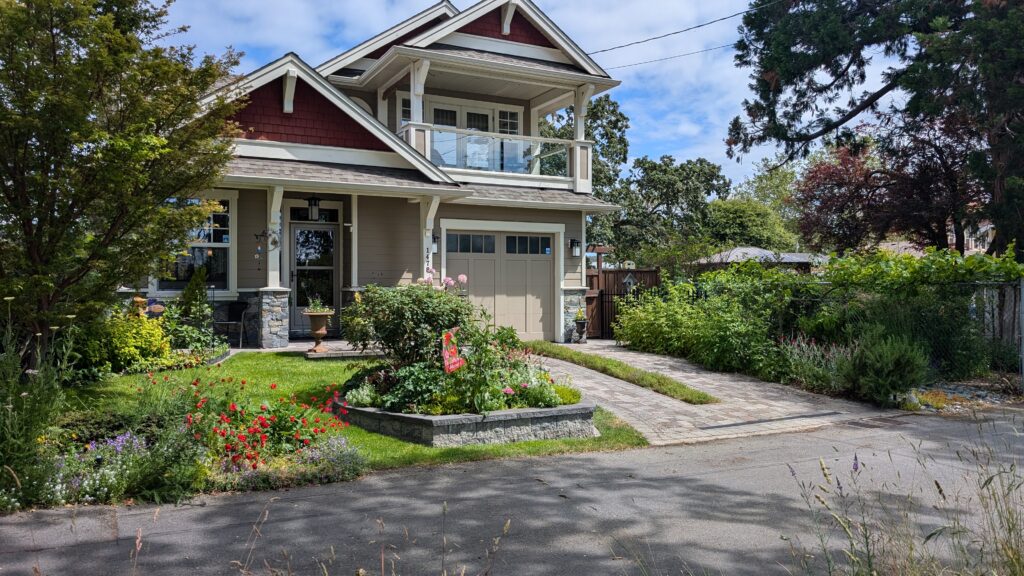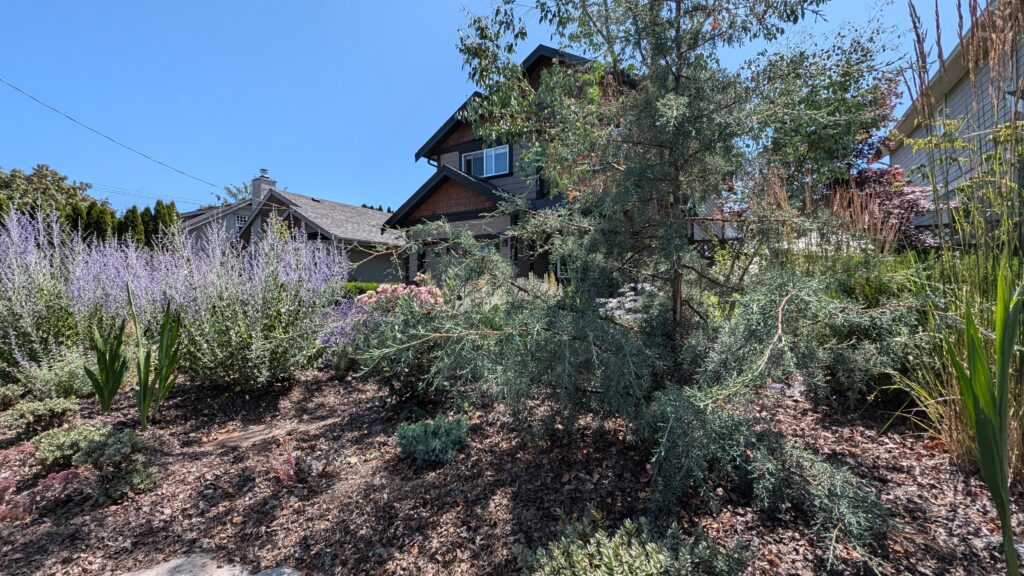Have you noticed how freaking hot it’s been lately? Here in Victoria, BC, longer periods of dry weather have become the norm. In fact, we’re breaking records across all of the seasons. The result is that our municipal reservoirs are draining faster, which is forcing city planners to tighten water restrictions. And it’s likely going to get worse.
Luckily, there are multiple options Victoria homeowners can employ to not only conserve water but capture it for future use. The best time to implement these strategies is during a home renovation or a new custom house build when the front and back yards are being dug up to accommodate new utility pipes or yard irrigation. Your contractor is a great source of cost-saving advice during this phase.
In this article, we’re going to break down the top seven ways to create low-maintenance, water-conserving landscaping around your home.
1. Drought tolerant plants
Installing plants that don’t require as much water is one of the central features of a landscaping strategy that can withstand dry weather. Some of these plants can go weeks and even months without a drop of water while still looking healthy. As expected, these plants have a sturdy, indestructible appearance.

Aim to landscape your property with a variety of plants with colours and textures that look good together, along with the perfect mixture of both blending and contrast. Try starting with longer-term plants like trees and shrubs as your foundation, then fill in the gaps.
If you’re looking for inspiration, Mediterranean gardens are well-known for using drought tolerant plants to withstand those long, hot seasons.
2. Rain gardens & water capture
If you’re trying to conserve water and make your home greener, one of the most self-sufficient things you can do is to capture the rain that falls from the sky. There are a couple ways you can do this as a homeowner.
One popular method of rain capture is called a bioretention facility, or a rain garden. A rain garden is a shallow depression landscaped into your yard that employs plants and soil to capture the water that runs off your roof and driveway. This type of garden can hold a few inches of rain, but most importantly the first couple centimeters, which carries the everyday household pollutants like oil, chemicals and pet waste. The toxins would normally end up in your local stream, inlet or waterway, but a rain garden traps the water and allows it to slowly seep into the ground. Rain gardens play a huge part in keeping our water supply clean and managing flooding in local neighbourhoods.
If you want to capture water in order to conserve water in your community, rainwater harvesting is a technique that’s been used around the world for literally thousands of years. This type of system uses a roof-like surface to redirect rain into a reserve tank, barrel or well. It’s quite simple. Whether you want to capture rainwater for drinking, livestock or irrigation, a rainwater harvesting setup can easily be designed and constructed on your property.
3. Permeable driveways
Another way to accommodate a dry climate and save water is by investing in a permeable driveway. Depending on which option you go with, there are multiple styles that can save water, be built with less material, and actually make your driveway look greener.
One option is what’s known as a ‘porous driveway’. A porous driveway is ideal for homeowners who want that look of a traditional driveway but also want to lower their carbon footprint. This type of driveway is built using a slotted patch of greenery which requires less material while protecting against run-off. Water will be preserved and surrounding landscapes will thrive.

Another option is natural stone pavers, which is a choice if you want your driveway to look truly unique. Different shapes and colours can be selected to create pretty remarkable patterns. Unlike concrete or asphalt, stone pavers are naturally occurring and don’t require CO2-emitting production. And if the pavers are spaced accordingly, this can be one of the eco-friendliest options as water is unable to run-off.
A third option is using plastic grid systems. Instead of concrete, asphalt or stone, your driveway can be filled in with grass or gravel. This type of driveway does not require salt when it snows, which reduces the environmental impact for surrounding bodies of water and ecosystems. Aside from its ‘green’ qualities, this option will also turn your driveway green if you opt for the grass filler option, blending your driveway with your yard and surrounding landscapes.
4. Terracing your property

This LEED home built on a hill near Prospect Lake is a great example of climate resistant terracing.
If you live in a particularly hilly neighbourhood that has left your yard with slopes, terracing your property with elevated areas and steps is a great idea. Terracing your property with walls and steps and elevated areas will help conserve water by allowing water to soak in place, rather than run down natural slopes in your yard.
These types of barriers work to contain soil and water, but they also limit erosion in run-off. Not only will this strategy conserve water, it will also work to make the ecosystems in your gardens healthier. Plus, using elevated gardens complete with sets of steps and retaining walls, your yard will look a whole lot tidier versus sloping landscapes that are difficult to contain and manage.
5. Add more hardscape
Hardscape elements like yard pathways, walkways, permeable paving, river stones, gravel beds and even garden art are a great alternative to water thirsty flowers, shrubs and other softscapes. These hardscapes require zero water themselves, and can instead re-distribute falling rainwater to their softer neighbours.

This hardscape strategy is already popular in desert climates like the Southwestern United States, where rain is rare and water limits are commonplace. But even here in southern Vancouver Island, we’re getting a taste of what it’s like to not get much water, now experiencing one of our driest summers ever.
The hardscape technique that employs yard pathways, paving, decorative stones and more is not only useful for water conservation. It turns out this landscaping method looks fantastic, too. Especially when you contrast hardscape elements with softscape elements like gardens, flowers and shrubs, it’s possible to create a designer-style yard right at home.
6. Mulching
If you aren’t mulching, you’re missing out. Mulch is a simple material added to the surface of soil that works wonders on your landscaping. Not only does it suppress weeds and cool the soil, mulch also retains moisture, saving water for the plants protected by it. It can also be obtained for a reasonable price, as organic mulch is made with anything from compost to tree bark to wood chips.

7. Watering Wisely
Regular watering may seem counterintuitive when talking about water conservation methods for especially dry climates, but the way in which you water can actually reduce your total usage.
- To start, drip irrigation is the most efficient way to water your beds, as water is delivered directly to the base of your plants without any evaporation.
- Another tactic is to water early in the morning or later at night – once the temperatures have dropped. This will go a long way in eliminating the risk of evaporation.
- The third and final strategy is all about how much water you use, and when. By watering plants with more volume but less frequently, you can actually coax their roots deeper into the soil, which will decrease their thirst. And beware of overwatering your drought resistant plants! They love dry conditions, and can develop root issues with too much water.

As shown, there’s plenty of great water-saving options when it comes to adapting to Victoria’s increasingly hotter and drier climate. To put yourself on the path to success, start your landscape planning at the beginning of your new home build or renovation. If you’re ready to take the plunge, Horizon Pacific Contracting can help.



